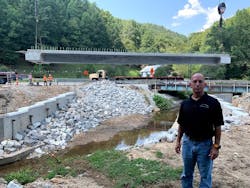The 10th edition of the AASHTO LRFD Bridge Design Specifications, to be published in 2023, will include revisions affecting the use of press-brake-formed steel tub girder (PBTG) bridges. These revisions were initiated by the Short Span Steel Bridge Alliance (SSSBA).
The Specifications employ Load and Resistance Factor Design (LRFD) methodology for use in the design, evaluation and rehabilitation of bridges and are used extensively in highway design and construction throughout the United States.
The revisions apply to Specification Equation 6.11.2.2-3, which is “intended to provide adequate boundary conditions at the web-top flange juncture of composite tub sections in flexure such that the web and compression-flange buckling formations with the specification are sufficiently accurate,” according to the ballot reviewed by the American Association of State and Highway Transportation Officials (AASHTO) T-14 Technical Committee for Structural Steel Design.
The revisions exclude PBTG bridges from the requirements of Equation 6.11.2.2-3, which were originally intended only for application to built-up tub-section members that utilize different- sized flange and web plates. They are not intended to be applied to tub-section members fabricated from a single plate, such as press-brake-formed tub-section members, that have been successfully used on shorter-span steel bridges.
“This is great news for state and local Departments of Transportation that are looking for economical, sustainable and accelerated construction solutions for short span bridges, which make up over half of the U.S. bridge inventory,” said Karl Barth, Ph.D., associate professor of civil and environmental engineering at the Wadsworth Department of Civil and Environmental Engineering at West Virginia University and leader of the team that developed the PBTG system, who has conducted extensive research on the PBTG system.
“It was not practical to apply these requirements to PBTG bridges and would have unintentionally excluded them as cost-effective solutions to replacing short span bridges. This is especially important as funding provided by the Bipartisan Infrastructure Law becomes available to replace off-system bridges because it creates an additional option for fixing the nation’s infrastructure.”
PBTG bridges are lighter than other materials, can be installed in hours by local crews, require minimal maintenance and are long-lasting. This provides an economical and sustainable solution for bridge owners. With shorter project times, PBTG bridge projects can reduce traffic disruption and provide sustainable benefits resulting from Life Cycle Analysis and recycling efficiencies.
------------
Source: Short Span Steel Bridge Alliance



